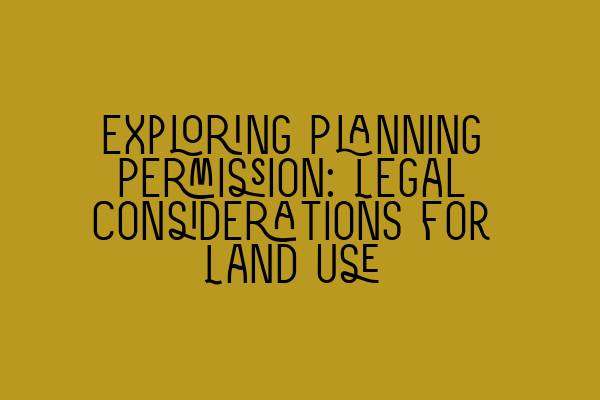Exploring Planning Permission: Legal Considerations for Land Use
When it comes to developing land or altering its usage, obtaining planning permission is a crucial step in the process. Planning permission is the legal authorization required from the local planning authority to carry out certain types of development. This permission ensures that any proposed changes or developments conform to the local development plan and relevant policies. In this article, we will explore the legal considerations involved in obtaining planning permission and how it can impact land use.
Understanding the Planning System
The planning system in the United Kingdom is complex and governed by a set of regulations and legislation. The Town and Country Planning Act 1990, along with various regulations and planning policies, form the backbone of the planning process. It is important to have a clear understanding of these laws and regulations to navigate the planning system effectively.
Obtaining planning permission is crucial before undertaking any development or change in land use. Failure to obtain permission can result in enforcement action, fines, or even injunctions. Therefore, it is essential to engage with the local planning authority and seek professional legal advice to ensure compliance with planning laws.
The Planning Permission Process
The planning permission process involves a series of steps that need to be followed to obtain the necessary authorization for development. These steps typically include:
- Pre-application consultation: Before submitting a planning application, it is advisable to engage in pre-application consultation with the local planning authority. This helps to gain an understanding of any potential planning issues and to address them proactively.
- Planning application submission: Once you are ready to proceed with your development project, a planning application must be submitted to the local planning authority. The application should include all relevant details, such as proposed plans, site surveys, environmental impact assessments, and any other documentation required.
- Public consultation: In some cases, planning applications may require a period of public consultation. This allows local residents, businesses, and other stakeholders to provide their views and feedback on the proposed development.
- Planning officer assessment: The local planning authority’s planning officers will review the application, assess its compliance with local planning policies and regulations, and evaluate any potential impact on the surrounding area.
- Decision-making: Based on the planning officer’s assessment, the application will either be approved, approved with conditions, or rejected. The local planning authority must provide a written decision within a specific timeframe.
- Appeals and legal recourse: If a planning application is rejected, there is a right to appeal the decision to the Planning Inspectorate. Alternatively, legal recourse may be sought if there are concerns about the lawfulness of the decision-making process.
It is crucial to have a strong understanding of the planning permission process and to seek professional legal advice to ensure that your application stands the best chance of success.
Legal Considerations for Planning Permission
When preparing a planning application, several legal considerations must be taken into account. These considerations include:
Development Plan Policies:
The local planning authority will assess the proposed development against the policies outlined in the development plan for the area. The development plan sets out the long-term vision and objectives for land use and development. It is essential to align your proposed development with these policies to increase the chances of obtaining planning permission.
Related Article: SQE 1 Practice Exam Questions
Environmental Impact:
Proposed developments must consider their environmental impact. Environmental impact assessments may be required for larger or more complex projects. These assessments evaluate the potential effects on the environment, including factors such as noise, pollution, and biodiversity.
Historic and Listed Buildings:
If your development plans involve a listed building or a building within a conservation area, additional considerations and permissions may be necessary. Listed buildings are protected by law, and any alterations or changes to them require specific consent.
Infrastructure and Utilities:
The availability and suitability of infrastructure and utilities, such as water, electricity, and sewage services, must be considered when applying for planning permission. Adequate provision of these services is essential for the sustainable development of land.
Neighbourhood and Community Impact:
A proposed development’s impact on the local neighbourhood and community will also be assessed. Factors such as traffic congestion, noise pollution, and visual impact on the surroundings are taken into account. Engaging with local residents and addressing any concerns they may have can help support a successful planning application.
Related Articles: SQE 1 Practice Mocks FLK1 FLK2, SQE 2 Preparation Courses, SQE 1 Preparation Courses, SRA SQE Exam Dates
Conclusion
Obtaining planning permission for land use is a complex process that requires careful consideration of legal requirements and thorough preparation. Engaging with a qualified solicitor specializing in property law can help navigate this process effectively and increase the chances of obtaining planning permission. Understanding the legal considerations involved, aligning with local planning policies, and addressing any environmental or community impact concerns are key factors for a successful planning application.
